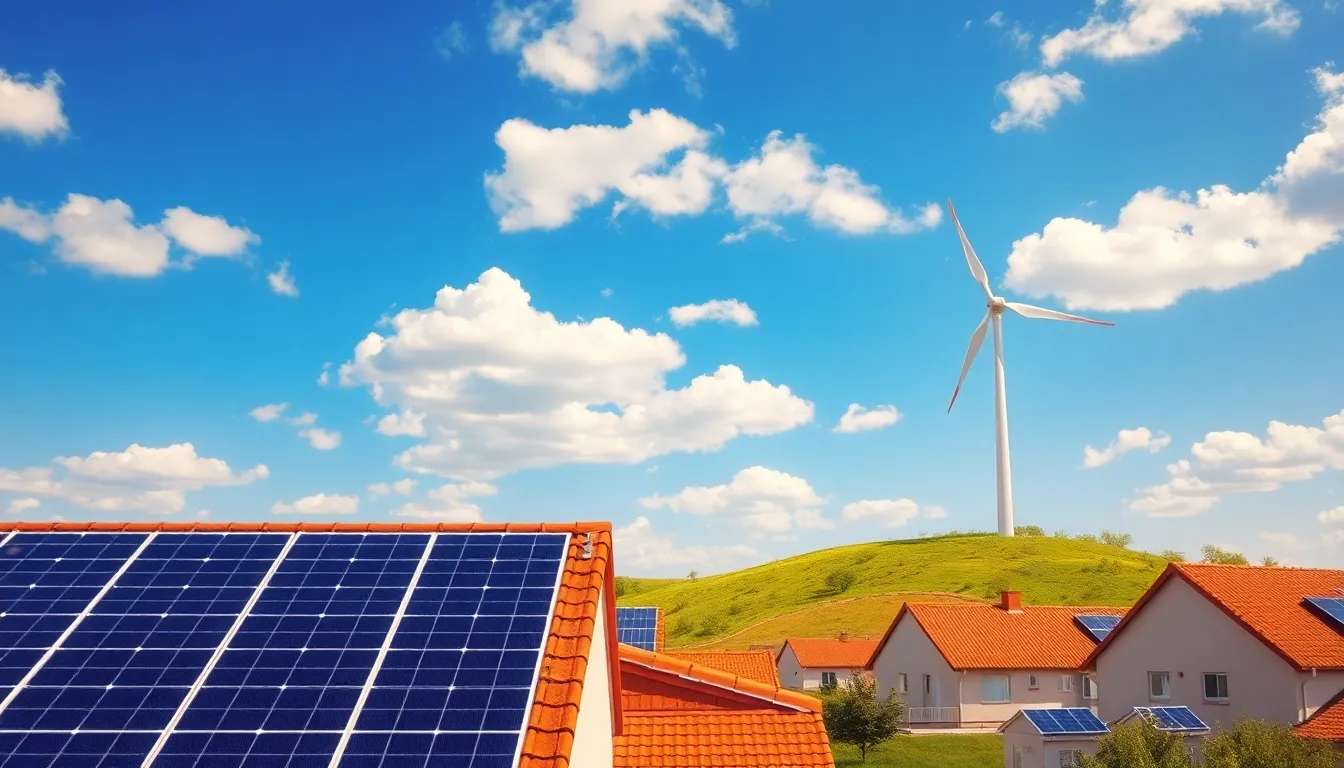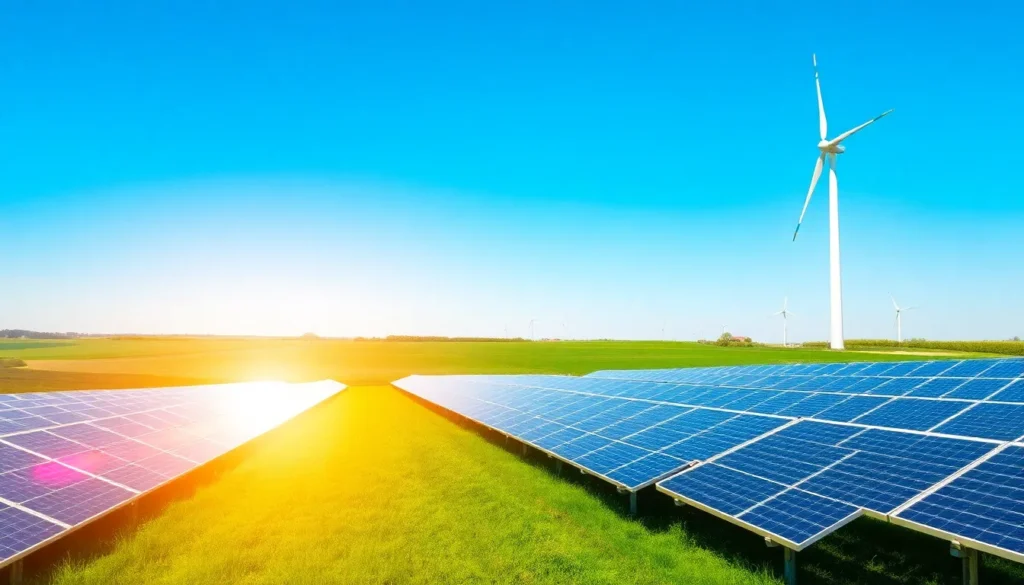In a world where fossil fuels are the aging rock stars of energy, renewable resources are the fresh-faced up-and-comers ready to take the stage. Imagine harnessing the sun’s rays, dancing with the wind, or tapping into the earth’s heat—all without leaving a carbon footprint the size of Bigfoot. It’s not just a dream; it’s the reality of renewable energy, and it’s here to save the day (and the planet).
As climate change looms like an unwanted party guest, embracing renewable resources isn’t just smart; it’s essential. From solar panels that soak up sunshine to wind turbines that spin like a rollercoaster, these resources offer a sustainable path to a cleaner future. So buckle up and get ready to explore how these eco-friendly heroes can power our lives while keeping Mother Earth happy and healthy.
Table of Contents
ToggleOverview of Renewable Resources
Renewable resources include energy sources that can regenerate naturally over time. Solar energy captures sunlight through photovoltaic cells. Wind energy harnesses air movement using turbines. Geothermal energy utilizes heat from beneath the Earth’s surface.
Biomass energy generates power from organic materials like plant and animal waste. Hydropower converts flowing water into electricity via dams or turbines. Tidal and wave energy exploits the kinetic energy from ocean movements.
These resources reduce reliance on fossil fuels, contributing to lower greenhouse gas emissions. As fossil fuel reserves diminish, renewable resources become increasingly essential for sustainable energy. Implementing these technologies can lead to energy independence and security.
Investment in renewable resources continues to grow, reaching over $300 billion globally in recent years. This trend demonstrates a shift towards cleaner energy solutions. Policymakers and consumers alike recognize the environmental and economic benefits of transitioning to greener technologies.
Employing renewable resources also promotes job creation in installation and maintenance sectors. According to the International Renewable Energy Agency, renewable energy employment could surpass 24 million jobs by 2030. This represents a significant opportunity for economic growth while addressing climate concerns.
Adopting these energy solutions plays a critical role in mitigating climate change effects. The transition to renewables stands as a crucial strategy for achieving a cleaner, healthier planet.
Types of Renewable Resources

Various types of renewable resources play crucial roles in creating sustainable energy solutions. Each resource emerges naturally over time and contributes to reducing greenhouse gas emissions.
Solar Energy
Solar energy harnesses sunlight to produce electricity and heat. It relies on photovoltaic cells to convert sunlight into usable energy. The expansion of solar technology has led to a significant decrease in costs, with prices dropping by over 80% since 2010. Solar panels can be installed on rooftops or in large solar farms, generating power for homes and businesses alike. In 2021, solar energy accounted for approximately 3% of U.S. electricity generation.
Wind Energy
Wind energy utilizes wind to generate electricity through turbines. These turbines convert kinetic energy from wind into mechanical energy, which is then transformed into electricity. Global investments in wind energy exceeded $100 billion in 2020, a clear indication of its growing prevalence. The U.S. alone produced 8.4% of its electricity from wind in 2021, showcasing its importance in the renewable landscape. Wind farms can often coexist with agricultural land, providing dual benefits to farmers.
Hydropower
Hydropower leverages the energy of flowing or falling water to generate power. It remains the largest source of renewable electricity globally, contributing nearly 16% of the world’s total electricity generation. Dams and run-of-the-river systems create opportunities for harnessing water energy efficiently. Environmental considerations and innovative technologies help mitigate impacts on ecosystems. In the U.S., hydropower accounted for around 6.6% of electricity generation in 2021.
Biomass
Biomass energy derives from organic materials, such as plant and animal waste. It converts these materials through combustion or biochemical processes into electricity, fuel, or heat. Biomass can reduce reliance on fossil fuels, directly affecting emissions. The U.S. produced about 5% of its electricity from biomass sources in 2021. This form of energy supports both waste management and renewable energy generation.
Geothermal Energy
Geothermal energy captures heat from within the Earth to generate electricity and provide heating. It relies on steam or hot water from geothermal reservoirs. This resource has a reliable output, making it an attractive option for baseload power generation. Significant geothermal resources exist across the western U.S., contributing to around 0.4% of the nation’s electricity in 2021. Enhanced geothermal systems continue to develop, promising even greater potential in the future.
Benefits of Renewable Resources
Renewable resources offer significant advantages that impact the environment, economy, and energy security. Their unique properties make them essential for a sustainable future.
Environmental Impact
Renewable resources greatly reduce greenhouse gas emissions. Solar panels and wind turbines generate energy without emitting pollutants, leading to cleaner air and water. Natural ecosystems benefit from this shift, as fewer harmful substances enter the atmosphere. Land use changes also occur with renewables, promoting biodiversity. For instance, responsible biomass sourcing can enhance soil health. Every aspect of this transition supports climate change mitigation efforts.
Economic Advantages
Investing in renewable resources generates substantial economic growth. Global investment surpassed $300 billion, demonstrating commitment to cleaner energy. The renewable sector presents cost-saving opportunities over time, as technologies improve and production scales. Job creation thrives in this field, with projections indicating over 24 million jobs by 2030. Wind, solar, and geothermal industries lead the way, offering resilience and adaptability within local economies. Communities enjoy diversified energy sources, bolstering economic stability.
Energy Security
Energy security strengthens as reliance on fossil fuels diminishes. Renewables diversify energy portfolios, decreasing vulnerability to price fluctuations and supply disruptions. Local resources, such as wind and solar, decrease dependence on foreign energy imports. A distributed energy model enhances resilience, allowing communities to generate power locally. Increased energy independence contributes to national security. As renewables continue to expand, they ensure a more stable, sustainable energy future.
Challenges in Implementing Renewable Resources
Implementing renewable resources faces several challenges. These obstacles can hinder the transition to sustainable energy solutions, impacting effectiveness and adoption.
Technological Limitations
Technological constraints significantly affect renewable energy development. Storage technologies struggle to efficiently hold energy generated from intermittent sources like wind and solar. Additionally, grid infrastructure often requires upgrading to manage decentralized energy flows. Companies face challenges in scaling up production to meet rising demand for renewable technologies. Innovations in efficiency remain crucial for enhancing the performance of existing resources. Overall, addressing these technological gaps is vital for optimizing renewable resource utilization.
Policy and Regulation Issues
Policy and regulatory hurdles create barriers in the deployment of renewable resources. Inconsistent incentive structures often exist between regions, which can deter investment. Regulatory frameworks may not adequately support new energy paradigms, leading to delays in project approvals. Clarity in long-term policies fosters investor confidence and increases the likelihood of successful implementation. Collaboration among governments, industries, and stakeholders is essential for creating cohesive policies that encourage renewable energy growth. Therefore, reforming regulations helps streamline the transition to sustainable energy.
Public Perception and Awareness
Public perception plays a crucial role in the adoption of renewable resources. Misconceptions about the effectiveness and reliability of renewables often persist in communities. Engaging educational initiatives can raise awareness about the benefits of renewable energy, addressing concerns and fostering support. Stakeholders need to emphasize success stories and tangible benefits that come with switching to renewables. By promoting positive narratives, the general public can become more receptive to renewable energy projects. Efforts to improve awareness are essential for driving widespread acceptance and utilization of renewable resources.
Embracing renewable resources is vital for a sustainable future. As the world shifts away from fossil fuels, the advantages of solar, wind, geothermal, and other renewables become increasingly apparent. These energy sources not only mitigate climate change but also drive economic growth and job creation.
The commitment to renewables fosters energy security and local independence while promoting cleaner air and water. Overcoming challenges like technological barriers and public misconceptions is essential for widespread adoption. By prioritizing education and awareness, society can harness the full potential of renewable energy. The transition to a greener future is not just an option; it’s a necessity for a healthier planet.




